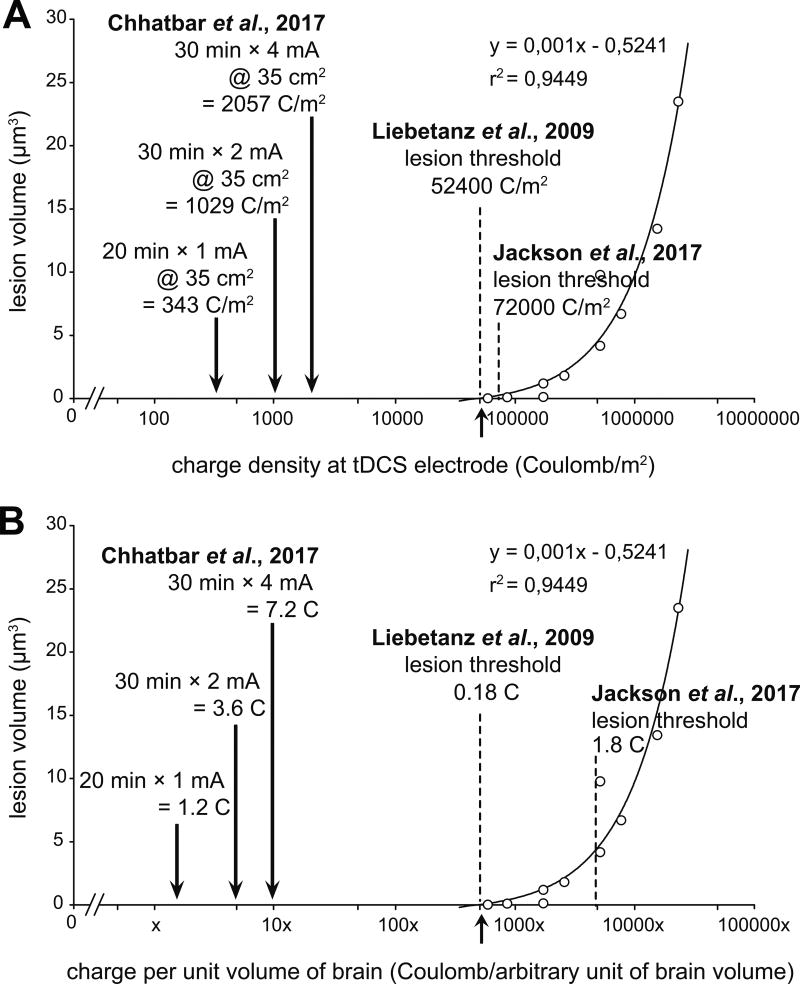Dear Editor
We do not agree with the conclusions of Jackson et al.1 that the transcranial direct current stimulation (tDCS) threshold for causing brain lesion in a rat model is well below that previously reported by Liebetanz et al.2 Jackson et al.1 used current density at the electrode as the primary measure of tDCS dosage, effectively ignoring that the duration of stimulation was 6-times that used in Liebetanz et al.2 However, duration is an important factor in electrical stimulation protocols. Charge density is a combined measure of current, electrode surface area and stimulation duration that is used in Liebetanz et al.2 Comparison of various tDCS parameters across various studies is made in Table 1. Charge density, as well as charge density per unit brain volume, are also compared in Fig. 1 across 3 studies.1–3 To conclude, by expressing tDCS dosage levels with current density instead of charge density, we believe that Jackson et al.1 have reached an incorrect conclusion regarding safety limits for animal brain. We mathematically demonstrate that when charge density is used to represent tDCS dosage, the safety limits established by Liebetanz et al.2 were substantially exceeded in the Jackson et al.1 study4.
Table 1.
Comparison of tDCS dose parameters (from Chhatbar et al.4)
| Publication | Current (mA) |
Pad Size (mm2) |
Duration (min) |
Current Density (A/m2) |
Charge (C) |
Charge Density (kC/m2) |
|---|---|---|---|---|---|---|
| Jackson et al. 2017 | 0.50 | 25.00 | 60.00 | 20.00 | 1.80 | 72.00 |
| Liebetanz et al. 2009 | 0.50 | 3.50 | 10.00 | 142.90 | 0.30 | 85.74 |
| Liebetanz et al. 2009 lesion threshold | 0.31 | 3.50 | 10.00 | 87.33 | 0.18 | 52.40 |
| Typical human tDCS study | 1.00 | 3500.00 | 20.00 | 0.29 | 1.20 | 0.34 |
| Chhatbar et al. 2017 | 4.00 | 3500.00 | 30.00 | 1.14 | 7.20 | 2.06 |
Figure 1. Jackson et al. 2017 actually shows higher safety threshold than previously reported by Liebetanz et al. 2009.
(A) Charge density plot. (B) Charge delivery per unit volume of the brain (arbitrary, assuming 2000× human to rat brain volume ratio - the total charge delivered to the human brain per unit volume is much smaller when compared with the rat brain.) Note the logarithmic scale on the azimuth in both the plots (from Chhatbar et al.4).
References
- 1.Jackson MP, et al. Safety parameter considerations of anodal transcranial Direct Current Stimulation in rats. Brain Behav Immun. 2017;64:152–161. doi: 10.1016/j.bbi.2017.04.008. [DOI] [PMC free article] [PubMed] [Google Scholar]
- 2.Liebetanz D, et al. Safety limits of cathodal transcranial direct current stimulation in rats. Clinical neurophysiology : official journal of the International Federation of Clinical Neurophysiology. 2009;120:1161–1167. doi: 10.1016/j.clinph.2009.01.022. [DOI] [PubMed] [Google Scholar]
- 3.Chhatbar PY, et al. Safety and tolerability of transcranial direct current stimulation to stroke patients - A phase I current escalation study. Brain Stimul. 2017;10:553–559. doi: 10.1016/j.brs.2017.02.007. [DOI] [PMC free article] [PubMed] [Google Scholar]
- 4.Chhatbar PY, George MS, Kautz SA, Feng W. Quantitative reassessment of safety limits of tDCS for two animal studies. Brain Stimulation. doi: 10.1016/j.brs.2017.07.008. doi: https://doi.org/10.1016/j.brs.2017.07.008. [DOI] [PMC free article] [PubMed]



